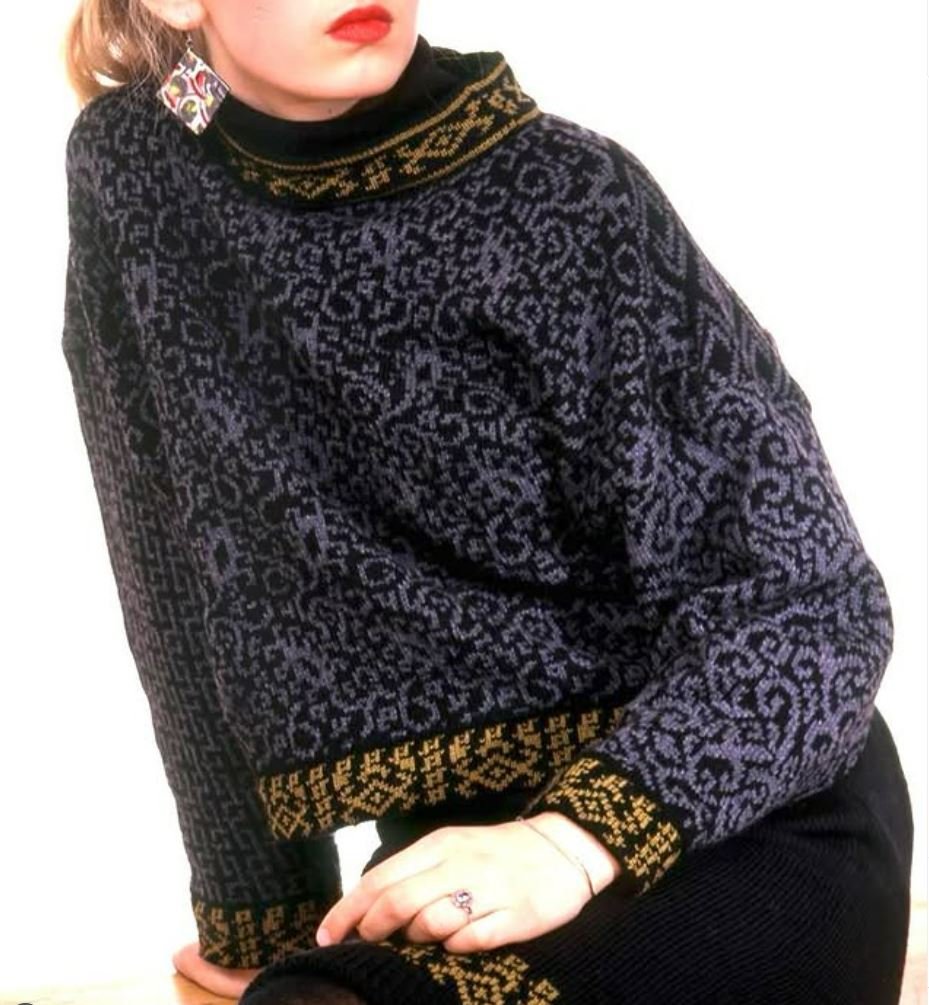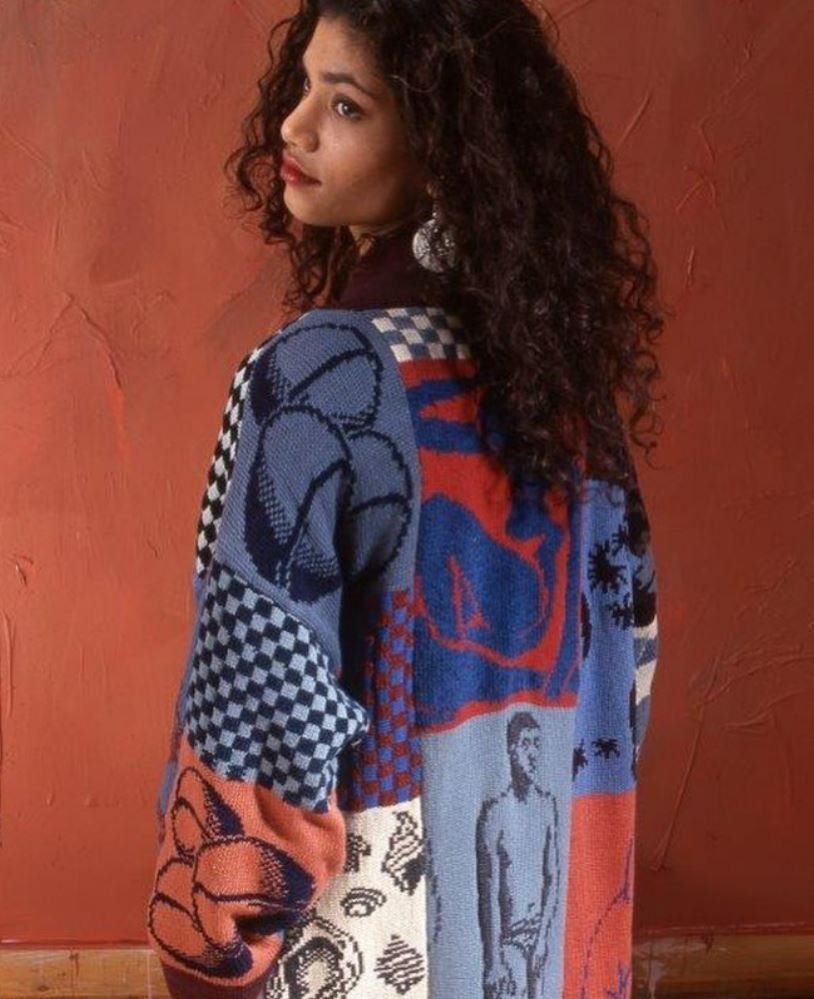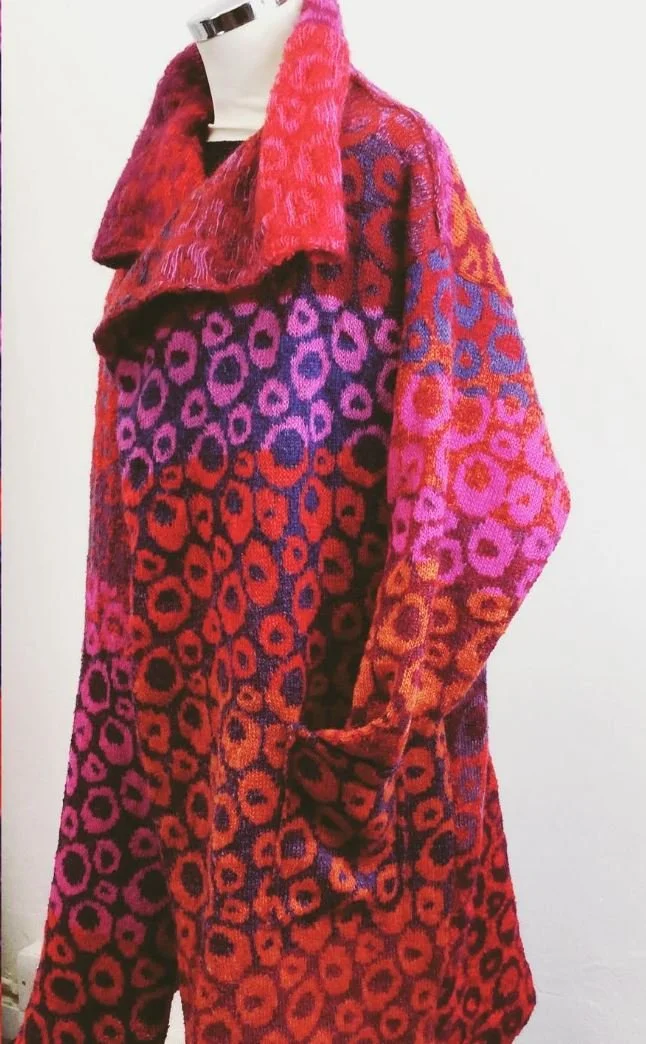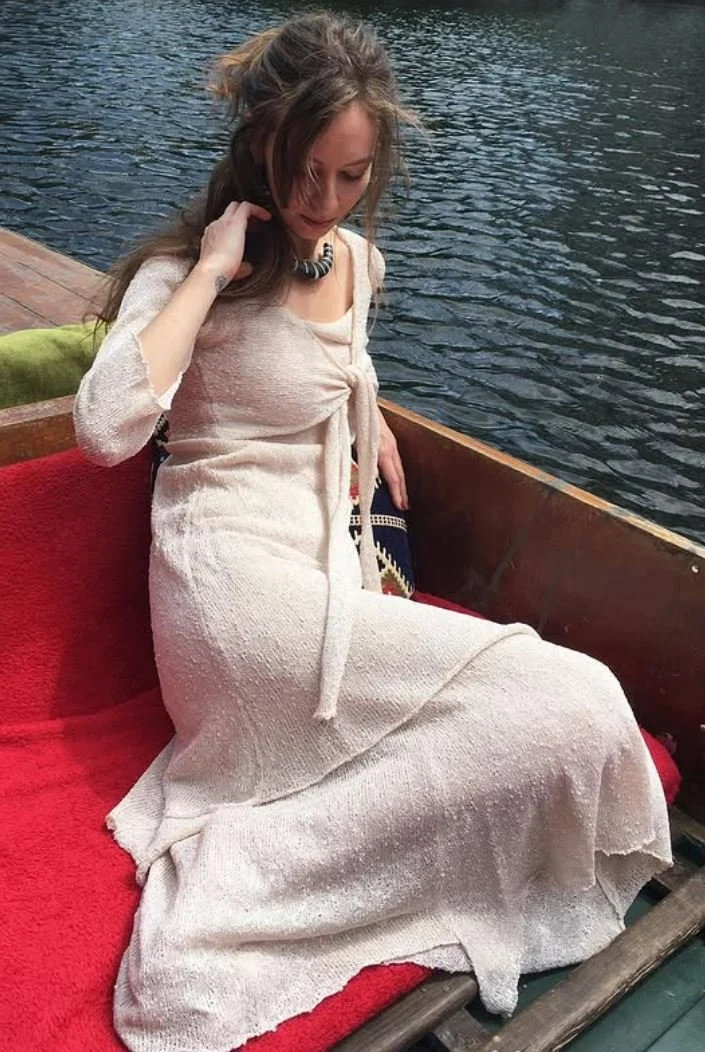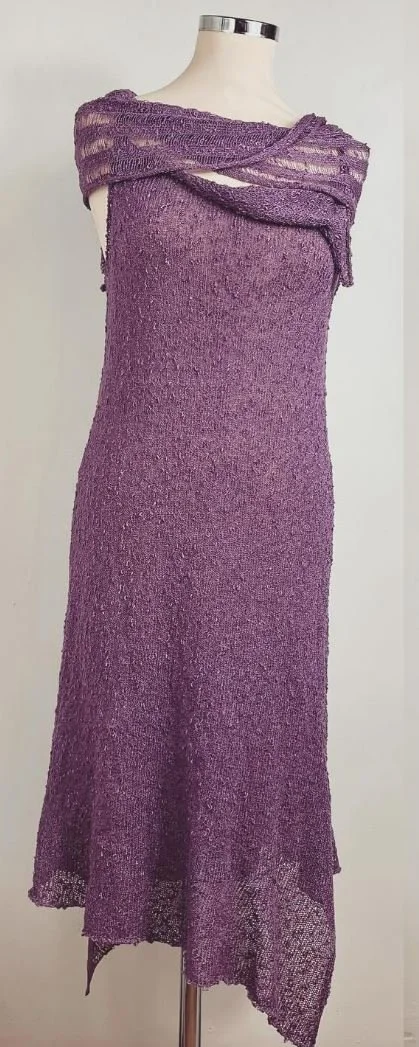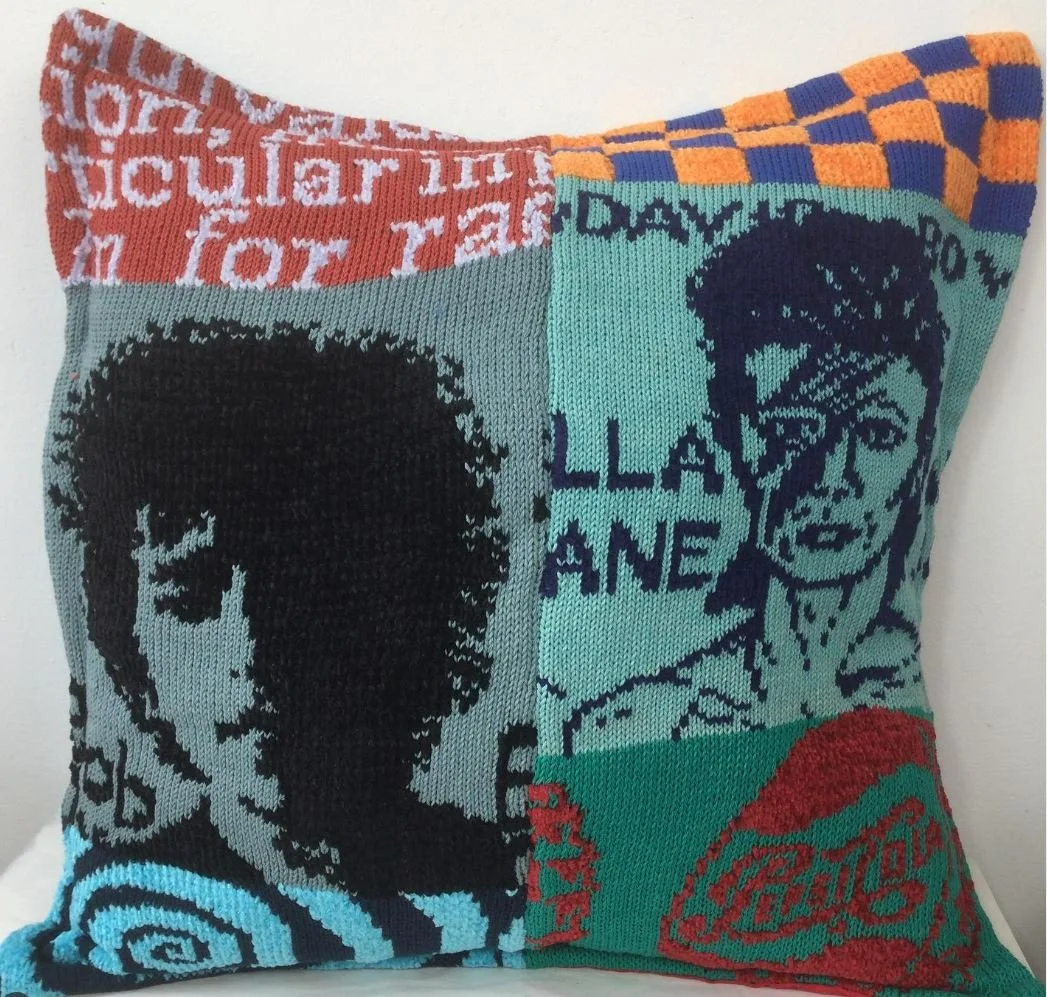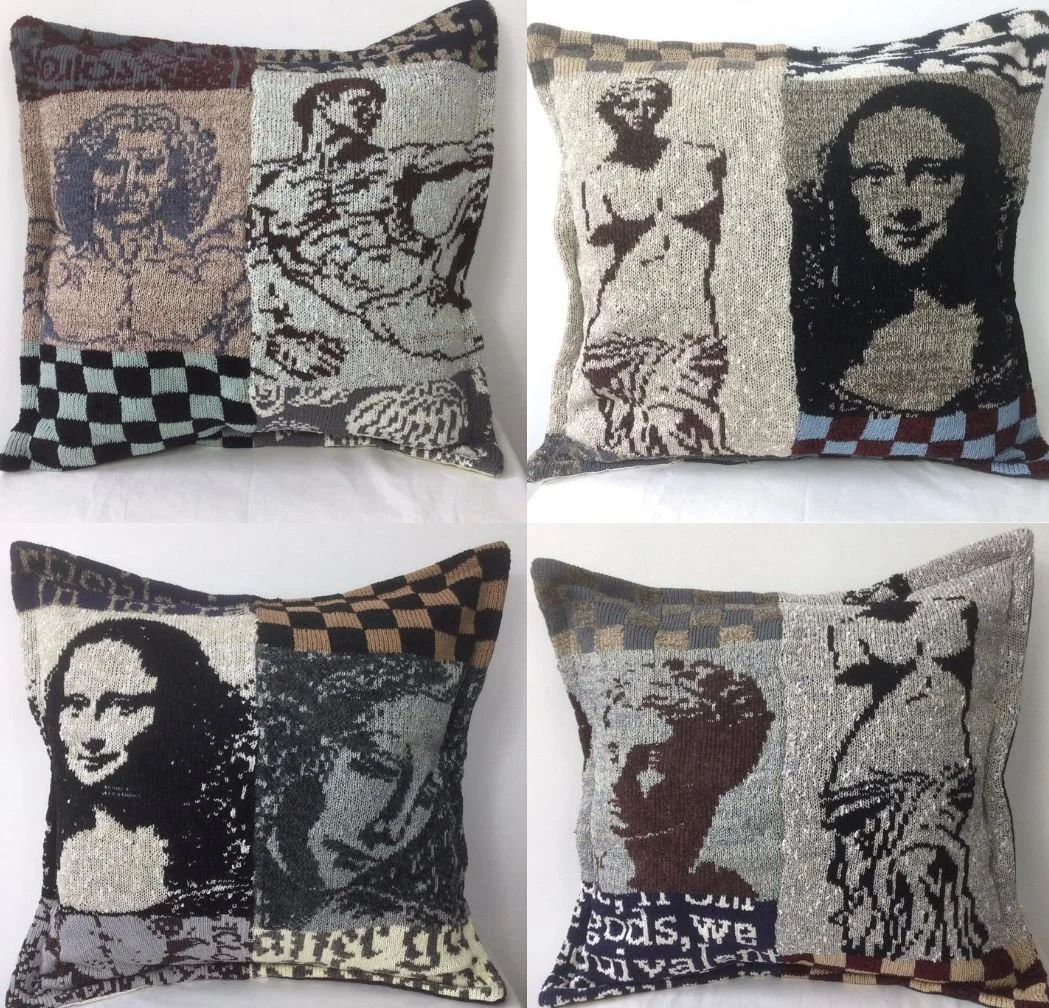The Story of Knitwear Designer Penny Burdett
In East London there is a small, leafy, district called Clapton. It is home to many sweet boutique’s, a pond which, on a rainy day, looks miserable but when the sun is out radiates joy, the famous Chatsworth Road Market, and knitwear designer Penny Burdett. It was a warm Wednesday morning when Penny graciously invited me to her home and studio in Clapton, to talk about her eponymous label that she has run for nearly 40 years.
Penny, born in 1948, designs and creates tops, dresses, hats, gloves, and even cushions, using an analogue knitting technique that has been around for decades. Next year Penny will have been making her clothing for 40 years, so I wanted to speak with her to learn more about why she loves knitting her designs , what it was like building her business in the 1980’s, and how she finds inspiration for her intricate patterns.
The first thing I noticed when entering Penny’s home is that she is truly an artist. Not just a knitter, but an artist. Her home is filled with artwork on the walls, acrylic paintings and pencil sketches, most of which she tells me is made by her three children, Jessica, Eleanor and Thomas. She tells me that Jessica, her eldest, is actually the head of the art department at a school in Deptford. We walk upstairs to her small but wonderous studio. The room is filled to the ceiling with different coloured yarns; yellows, blues, greys, reds, purples, oranges, whites, all made from viscose, wool, cotton, mohair and boucle yarn. Once I have taken in the fortress of fabric, my eyes fall to a machine unlike anything I have ever seen, the Knitmaster 360. Looking straight out of the Victorian era, the large machine reminds me of a stripped-back piano, but instead of black and white keys, it has hundreds of little needles, each one vital to creating specific patterns. The machine has two large slender poles coming out the back, with three different coloured yarns attached. Penny is midway through making a scarf ordered by a client of hers: “This is my first attempt at the pattern, I’ll hopefully get it right on the third attempt.” The scarf has cascades of water patterns interchanging between purple, white and blue.
“I recently went to Italy for two weeks where I had loads of time to think of new patterns. I have made over 400 different patterns in the past 40 years.”
She shows me just a handful of the punch cards with her patterns cut out; the cards are placed into the top of the Knitmaster 360 and the hundreds of needles move accordingly to knit the pattern. It is refreshing seeing the design and creation processes of her work being fully analogue. Not that there is anything wrong with working electronically, but there’s a element of physicality to Penny’s work that you seldom come by anymore.
After showing me the punch cards Penny finally asked me the question that I had been waiting for: “Do you want to see how the machine works?”. She turns around in her chair and quickly drags a thick plastic block across the hundreds of needles, making a noise that reminded me of those huge paper cutters we had in primary school, and a new stitch was made. That was it. In less than five seconds she had moved three different threads across hundreds of needles. It is spectacular in its simplicity.
Penny began selling her unique designs at Camden Lock in 1986. “I would get there at 8.30 in the morning to get a space in the market. A man named Eric Reynold’s would give everyone in the queue a raffle ticket and if your number was selected then you would have a stall that day. It wasn’t fair really, but some days you would just have to go home with all of your kit.” Her foray into fashion designing began much earlier than Camden Market however: “My mother was a great clothes maker, and I began making clothes for my dolls when I was a kid.” A little later, Penny attended Leeds Arts College to study graphic design, following which she spent three years working in animation.
Eventually, Penny was given a permanent location at Camden Market: “Eric would come and look at you and your work and decide if you were worth it. He saw how special my work was.” Special her work definitely is, as no two pieces of clothing are the same. Penny’s work is individualistic and personal, making clothes with heart. The physical nature of the Knitmaster means that human error happens, adding endearing ‘mistakes’ into creations. It also means that each stitch can be customised, there are thousands of variations within each of Penny’s patterns. The above image (left) shows a model named Ana wearing an off-white tunic top tied at the chest, and a matching skirt. The perfect outfit for a cool summer day. Opposite is one of Penny’s asymmetrical dresses in aubergine. What is genius about Penny’s designs is that they have as few seams as possible, some even with none, giving them longevity: “They last forever because they are just one continuous piece of fabric with no seams.”
For 38 years Penny sold her designs in Camden, until June of last year when she unfortunately had to close her store: “It is a shame because I knew so many people at the market, some of whom have now also left.”
“The rent went through the roof. It is a shame because now at Camden market there are loads of places selling not very good products for extremely cheap, and people like me cannot compete with the prices.”
She added: “Unfortunately my turnover was the same as it was 20 years ago.”
Just six months before the Covid pandemic began Penny and a freelance photographer that Penny has worked with, Cedric Migroyan, set up an online shop to sell Penny’s clothing and cushions: “It was really lucky timing.” Penny now sells mostly online, but clients can also make appointments to come visit her studio in her home. She also partakes in various pop-up markets across London, which is actually how she and I met. It was a lovely coincidence that we met, as I was simply walking around Hackney as I had a bit of time before work, when I came across a poster for the Arts and Crafts Trail. It turned out it was the last day of the trail, so I decided I could risk being late for work and I had a look at some of the local artwork. The E8 Arts and Crafts Trail is twice a year, once in the summer and once in the winter, and is ran by local artists to promote their work for cheap. It was in a pub called The Prince George that I came across Penny’s stall. I remember being drawn to a black and white striped knitted fez hat; her hats are her bestsellers I am later told, which I quickly bought. Penny and I got to chatting and the rest is history.
As mentioned it is not just clothing that Penny makes, but also customised cushion cases, or as she calls them ‘ArtKnit cushions’. As shown above, Penny knits famous faces, artworks and silhouettes into cushion covers. It is a precise type of knitting which I think is undervalued for its artistry. Upon first glance Penny’s work seems like well-made, fun cushion covers, but once you actually look at the patterns for long enough you realise how complicated and masterful they are. Penny’s cushions are not only patterns making faces, but also patterns making emotions. Take the patterns of the Mona Lisa for example, Penny brilliantly captures her iconic smile using an almost scary amount of accuracy with her Knitmaster.
A great thing about Penny is that she is a very comforting person to talk to. She is not afraid to be herself and say what is on her mind. At one point she tells me about the time Kate Bush came into her store in Camden. “I did not notice that it was her and I found her to be a bit demanding so I didn’t help her. She looked a bit old and ratty.” Who else would describe Kate Bush as ‘old and ratty’? Brilliant. “As a kid I moved a lot so I got used to being the new girl in school, and used to always meeting new people. I can talk to anyone.” Both of Penny’s parents worked in the Royal Air Force (RAF), and met in 1946 while playing in an RAF amateur theatrical production. The pair were married a year later, and lived in Blackheath when they had Penny. Shortly afterwards, Penny’s younger sister Sarah was born in 1950, and in 1952 their parents returned to the RAF. This led to the family moving around a lot, from Ceylon, to Singapore, to Painswick, to Scotland, to the Lake District, and finally to Cornwall.
Towards the end of our conversation, I learned a valuable lesson from Penny, and that is to never ask an artist how long their art takes. “I always tell people who ask me that, it took me about 38 years of experience.” I initially pushed back a little, arguing that I would ask a painter how long a painting of theirs took simply out of curiosity, but Penny ardently replies that “asking that question is very rude”. Reflecting on her stance, I suppose she is correct. By asking a designer how long a garment took to create, you are actually asking how much it is worth. In Penny’s case, her work is worth a lot as she controls every part of the creation process, from designing the pattern, to punching the pattern into the card to be placed into the Knitmaster 360, to then selecting which yarns to use, to then actually making the garment, to then promoting her work and selling it. It is no easy task, but Penny continues to do it, and continues to make curious and unique designs.
